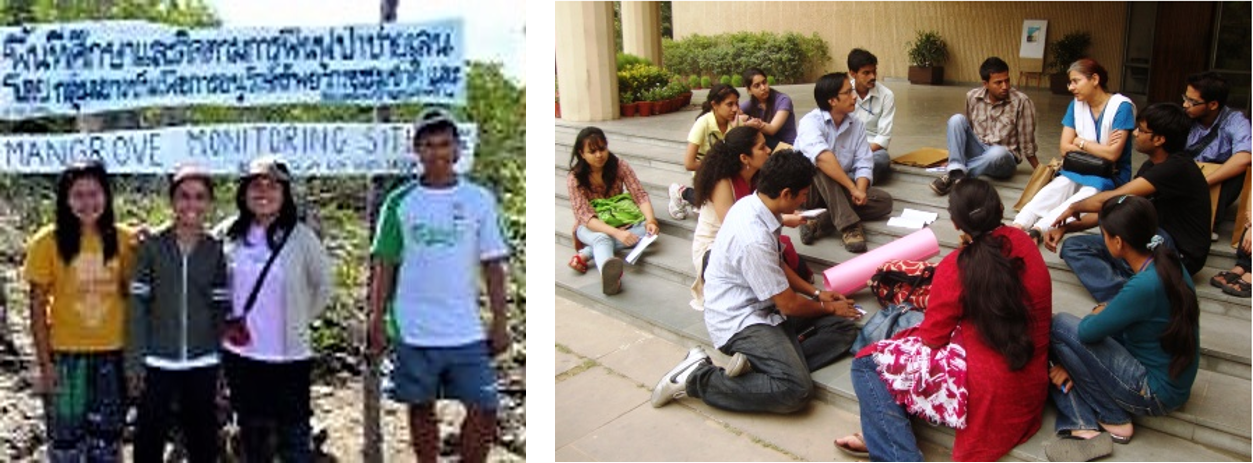Executive Summary
Empowering young people as promoters in the field of water and sanitation is a way of assuring that a project or programme has a greater effect and more long lasting impact on the communities. When trying to find solutions to water contamination and ways to improve access to water and sanitation in any given community, it is essential that youth become involved, so they themselves can work together in an organised fashion to identify appropriate solutions to the problems, and then take ownership” of the measures to apply those solutions. There are many tools that can be applied in order to involve youth in social or environmental action. This can help raise their self-esteem and also encourage other youth to take similar actions.
Why Involve Youth?
Young people need opportunities to develop skills, and when adequately directed can easily and effectively support organisational work without a lot of experience. Environmental programmes should try to involve young people as promoters basically because they have a lot of extra time and energy — and are tremendously creative. In this media age, young people have access to tremendous amounts of information that can sometimes be overwhelming (using internet based social networks, for example), but they really do not know what to do with all of it.
Making the Change
Young people are prepared to take risks in confronting conventional structures. They are a sector of society that will be able to assure sustainability. Precisely because they are inheriting a world, they know that the world is complicated and it will affect them. Indeed, young people are often more sensitive and intuitive than many adults, which can give them and almost instinctive sense of what will work or not and where a program should be directed.
“One way to make sure change lasts is to work with young people, because they will take what they learn into the future. Each of us, no matter what age we are, can adopt the attitude of a young person to always be willing to learn and try new things” (CONANT et al. 2008).
Barriers and Challenges to Involving Youth
If and when youth do want to get involved in social and environmental programmes and movements, the traditional leaders and decision makers are frequently threatened by them and prefer not to involve them in their plans. Although this resistance is partly due to a lack of tools on how to involve them, it is frequently also due to a basic lack of understanding. Adults treat youth as adults — which they are not! — so their methods to involve them tend to fail; thus making it more likely that the programme strategies and activities will not be accepted by the youth.

Skills Needed by Youth to Promote Water and Sanitation Issues
To prepare young participants for advocacy requires awareness building, training, and skills transfer from specialists in a number of key areas including:
- Internet-based social networks
- Policy aspects of the right to water and the right to sanitation
- Social justice and equity
- Rhetoric and debating skills
- Decision-making and group facilitation tools
- Marketing skills
- Environmental health
- Problems related to water and sanitation
Tools Commonly Used by Youth to Promote Water and Sanitation Issues
Important tools used by youth to promote water-related issues include: door-to-door campaigns, water forums and brigades, school environmental groups, art contests, online and printed publications, educational radio and theatre shows, concerts, amongst others. Other information tools provide support on how they let other people know what their accomplishments are. This includes how they choose to generate their messages, and allowing them to be protagonists of change amongst school and community authorities.
Facts to Consider
Young people are empowered by knowing that they have the capacity to influence change, i.e., if they can see what they achieve. In the case of water quality, for example, it is useful for them to identify that their actions can directly influence the quality of water that they consume, e.g. by measuring the water quality or researching improvements in health or biodiversity. Therefore, any action plan to deal with the prioritised and analysed issue should be geared towards attaining small, reachable goals. An attitude of not pointing out errors, but rather finding more about the goal they set in their action plan, is a way of promoting the change they want to see.
Youth Projects and Programmes
By forming or joining existing youth networks, as well as maintaining contact, young people are also empowered. But when at a teenage stage, and if coming from needy or poor communities, they may have a demand on them to contribute to the family economy. Committed youth groups can begin to break down under external life pressures, including both economic and family demands. Romantic involvement and pregnancy can have a heavy toll on the best of intentions. This is why it is important to think through and put in place strategies for maintaining the involvement of motivated youth over the long haul. For example, considering introducing small stipends for the more mature and experienced youth, as a transition from purely voluntary work; access to training, stimulus attached to internet and media, and certification can also be important incentives.
Conclusion
Cultivating an understanding of global perspectives and of international development issues is of special relevance to any environmental youth educational program. It is the young people that day to day play a more transcendental role in any country’s economic, political, cultural, academic and social activities. By allowing them to take ownership of different means of expression, and in as much as they receive support from different civil and governmental groups, they will be influential in supporting the sustainability agenda (KURI et al. 2006).
The nature of water awareness programmes in schools and universities is to directly expose youth to problems that the underserved populations are facing, and what governance issues play into the picture. These educational programmes can help promote serious reflection and discussion on issues such as water depletion, wastage and pollution, degradation, water related conflicts, and recent moves to privatise water.
For example, watershed monitoring, connecting schools upstream and downstream and information sharing and networking each other, is a great way to observe the impact of their settlement at a bioregional perspective. Community youth programmes often like to get involved in cleaning and protecting of the communities’ water source through different collective eco-restoration actions.
Through these types of activities, youth can gain awareness about the growing urgency of issues related to water both locally and globally. So not only can environmental educational programmes help highlight the magnitude of the problem, but also bring all stakeholders together to apply solutions that work. Today’s young people are those that take tomorrow’s decisions - their involvement in today’s problems are thus crucial!
A Community Guide to Environmental Health
A comprehensive Guidebook to Environmental Health that helps promoters, development workers, educators, activists and community leaders take charge of their communities´ environmental health. Published by Hersperian Foundation the editors of the rural health bible “Where there is no Doctor”
CONANT, J. FADEM, P. (2008): A Community Guide to Environmental Health. Berkeley, CA: Hesperian Foundation URL [Accessed: 25.04.2019]Ecohábitat, Experiencias Rumbo a la Sustentabilidad
Language: Spanish
DYSoC Day 1: Delhi Youth’s Eco-Rendezvous on Environment Day
A Community Guide to Environmental Health
A comprehensive Guidebook to Environmental Health that helps promoters, development workers, educators, activists and community leaders take charge of their communities´ environmental health. Published by Hersperian Foundation the editors of the rural health bible “Where there is no Doctor”
CONANT, J. FADEM, P. (2008): A Community Guide to Environmental Health. Berkeley, CA: Hesperian Foundation URL [Accessed: 25.04.2019]Ideas for Water Awareness Campaigns
This document includes a section for advocacy, presenting an overview of many ideas and initiatives with emphasis on practical suggestions and clues. It is not a guidebook for planning your advocacy work but it might be a great knowledge source and starting point for your activities.
SCHAAP, W. STEENBERGEN, F. van (2001): Ideas for Water Awareness Campaigns. Stockholm: The Global Water Partnership URL [Accessed: 24.06.2019]Youth Lead Community Efforts Toward a Cleaner, Greener Anacostia Watershed
Case study of collaboration between the US EPA and the Earth Conservation Corps, a youth led organization, in protecting and cleaning the Anacostia Watershed in Washington DC, USA.
U.S. Environmental Protection Agency (2008): Youth Lead Community Efforts Toward a Cleaner, Greener Anacostia Watershed. URL [Accessed: 25.04.2019]How to Organize a Youth Water Congress
Guide to Action. Simple Steps towards Change
MDG Youth Action Guide. Guide to youth action in general, includes workbooks to be downloaded and useful links.
TAKING IT GLOBAL (n.y): Guide to Action. Simple Steps towards Change. Taking it Global URL [Accessed: 22.07.2010]Young People conducting Environmental Tracking and Assessment for Health in the Yucatán Hydrological Basin
Cuerpos de Conservación Mexicanos, A.C. Young People conducting Environmental Tracking and Assessment for Health in the Yucatan Hydrological Basin. Short article that describes the participation of youth in a water-monitoring program in Yucatan, Mexico.
Gender mainstreaming in water and sanitation
This link highlights the importance of gender mainstreaming to achieve gender balance and reduce inequality.
Centre for Affordable Water and Sanitation Technology (CAWST)
The homepage of the Centre for Affordable Water and Sanitation Technology (CAWST) provides general descriptions of sustainable drinking water treatment technologies and water, sanitation and hygiene issues. The publications section in particular can provide you with important information.
Global Youth Action Network
Official website of Global Youth Action network, contains links to more than 1,200 youth-led and youth-serving organizations in more than 190 countries.
World Youth Water Alliance (WYWA)
Official website of the World Youth Water Alliance (WYWA), an organization focused on engaging youth at both local and global level, throughout the year and especially on 22nd March, the World Water Day (WWD) to organize various programs and events up to the year 2015.
Youth Water Network
Official website of the Youth Water Network a European Youth organization dedicated to solidifying networks, organizing Water Congress, raising awareness on water related issues. The network was launched during “Splash!” (The Third European Youth Congress for Water) in Belgium, March 2003. The website includes a good selection of manuals and materials including “How to organize a Youth Congress”.


